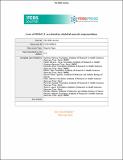Por favor, use este identificador para citar o enlazar a este item:
http://hdl.handle.net/10261/222923COMPARTIR / EXPORTAR:
 SHARE SHARE
 CORE
BASE CORE
BASE
|
|
| Visualizar otros formatos: MARC | Dublin Core | RDF | ORE | MODS | METS | DIDL | DATACITE | |

| Título: | Loss of HDAC11 accelerates skeletal muscle regeneration in mice |
Autor: | Núñez‐Álvarez, Yaiza; Hurtado, Erica; Muñoz, Mar; García-Tuñón, Ignacio CSIC ORCID CVN; Rech, Gabriel E. CSIC ORCID; Pluvinet, Raquel; Sumoy, Lauro; Pendás, Alberto M. CSIC ORCID ; Peinado, Miguel A.; Suelves, Mònica | Palabras clave: | Cell cycle exit HDAC11 IL-10 Satellite cells Skeletal muscle regeneration |
Fecha de publicación: | feb-2021 | Editor: | Federation of European Biochemical Societies John Wiley & Sons |
Citación: | FEBS Journal 28(4): 1201-1223 (2021) | Resumen: | Histone deacetylase 11 (HDAC11) is the latest identified member of the histone deacetylase family of enzymes. It is highly expressed in brain, heart, testis, kidney, and skeletal muscle, although its role in these tissues is poorly understood. Here, we investigate for the first time the consequences of HDAC11 genetic impairment on skeletal muscle regeneration, a process principally dependent on its resident stem cells (satellite cells) in coordination with infiltrating immune cells and stromal cells. Our results show that HDAC11 is dispensable for adult muscle growth and establishment of the satellite cell population, while HDAC11 deficiency advances the regeneration process in response to muscle injury. This effect is not caused by differences in satellite cell activation or proliferation upon injury, but rather by an enhanced capacity of satellite cells to differentiate at early regeneration stages in the absence of HDAC11. Infiltrating HDAC11‐deficient macrophages could also contribute to this accelerated muscle regenerative process by prematurely producing high levels of IL‐10, a cytokine known to promote myoblast differentiation. Altogether, our results show that HDAC11 depletion advances skeletal muscle regeneration and this finding may have potential implications for designing new strategies for muscle pathologies coursing with chronic damage. | Versión del editor: | https://doi.org/10.1111/febs.15468 | URI: | http://hdl.handle.net/10261/222923 | DOI: | 10.1111/febs.15468 | ISSN: | 1742-464X | E-ISSN: | 1742-4658 |
| Aparece en las colecciones: | (IBMCC) Artículos (IBE) Artículos |
Ficheros en este ítem:
| Fichero | Descripción | Tamaño | Formato | |
|---|---|---|---|---|
| Loss_Nuñez_Postprint_Art2020.pdf | 4,79 MB | Adobe PDF |  Visualizar/Abrir |
CORE Recommender
SCOPUSTM
Citations
13
checked on 10-abr-2024
WEB OF SCIENCETM
Citations
12
checked on 29-feb-2024
Page view(s)
169
checked on 21-abr-2024
Download(s)
293
checked on 21-abr-2024
Google ScholarTM
Check
Altmetric
Altmetric
NOTA: Los ítems de Digital.CSIC están protegidos por copyright, con todos los derechos reservados, a menos que se indique lo contrario.
